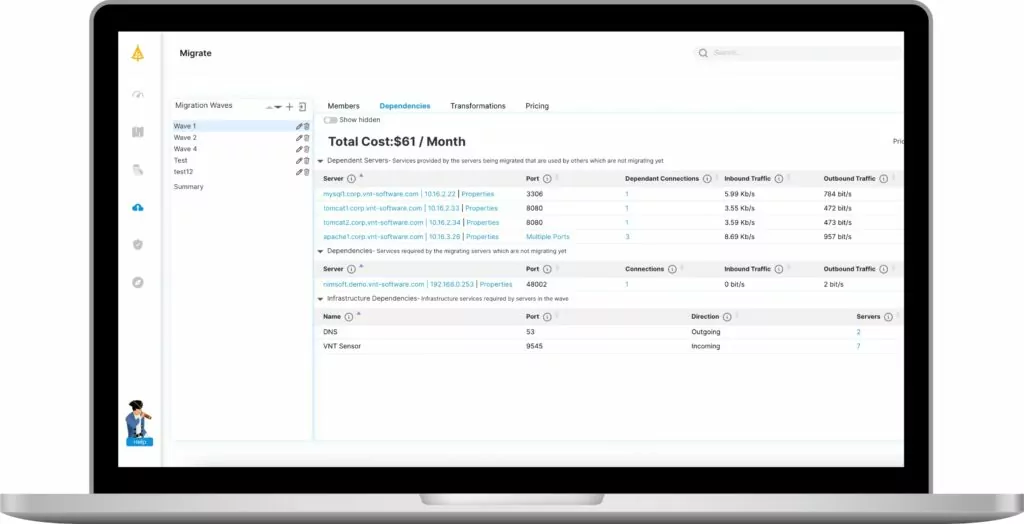Today’s average data center houses zettabytes of data and thousands of shared applications. This makes continuous data-center evolution the key to business competitiveness and innovation. The increasing demands of a hybrid remote workforce, energy costs, carbon-footprint concerns, and other factors are driving this need to evolve.
All data centers face the challenge of handling huge data volumes and managing workloads across broader environments. The major aspects of security, regulatory compliance, and disaster recovery and backup are now part of a Gordian Knot of complex challenges for every data center. (For more information, see our Guide to Cloud Migration.)
Table of Contents
ToggleSmall and midsize businesses (SMBs), as well as enterprises, must maintain data security and ensure legacy infrastructure performance while delivering ROI. This now requires future-proofing via cloud and edge technologies to maintain maximum agility to respond to changes in direction and scale based on dynamic usage. IT is the only approach that ensures data centers can extend their capabilities in a world where growing CapEx and expansion costs are untenable.
As the role of cloud and edge computing increases, data centers have more options to meet the need for expanded capabilities while lowering costs and reigning in physical footprints and distributed locations. It’s predicted that over 50% of IT infrastructure will be edge deployments by 2023, according to IDC.
Managing workloads at the edge and across hybrid multi-cloud platforms brings its own challenges to IT leaders. But retiring a data center isn’t always a viable option, meaning other forms of transformation become the best approach to meeting complex and dynamic business needs. Although there are many reasons for transformation, several stand out as the most common among a majority of organizations.
Reasons for Data Center Transformation
The term “data center transformation” can have various meanings depending on the organization. It essentially means that an organization has either run out of space, i.e., capacity, or hit a wall with legacy infrastructure that cannot handle current digital transformation and business requirements. The resulting unsustainable total cost of ownership (TCO), where CapEx for hardware and the associated maintenance costs are unsustainable for growth, creates the impetus for data transformation.
Power, Cooling, Space, and Sustainability
Energy consumption, cooling costs, and footprint limitations affect both small businesses and global enterprises. The cost and complexity may be proportionally different based on data center size, but the need to maximize output, scalability, connectivity, and footprint is equally critical for both small and large data centers. Organizations can see this in the massive increase in kilowatts (kW) per server rack. The result is an even greater strain on space, cooling, energy, and sustainability for on-premises approaches to the data center.
In 2021, data centers around the globe collectively used as much as 320 terawatts of electricity per hour, according to the International Energy Agency (IEA). While this translates to over 1% of global final electricity demand, individual data center operators feel the unsustainable heat (servers running hot) and the resulting costs. This results in energy consumption and carbon-footprint reduction becoming a shared responsibility based on unsustainable data center and environmental costs.
Accommodating AI/ML, IoT, and Analytics
Data center transformation in the digital age is also being driven by AI/ML, analytics, and IoT, which have become foundational to business competitiveness, productivity, and innovation. This makes all data big data where high-performance computing (HPC) is often required to deliver the processing compute power. Although HPC has traditionally affected larger enterprises, small to medium enterprises (SMEs) and startups are also facing this need.
The growth of IoT platforms and the massive amounts of data they create often require the use of on-premises, cloud, and edge data centers that can take advantage of 5G for low latency when needed. Data lakes and warehouses for unstructured data and the big data architecture that supports them require the means to efficiently and cost-effectively migrate that data for storage and later analysis. Low-latency edge processing can also play a part in IoT sensor data transmission, storage, and analysis as these networks expand.
While AI/ML and analytics are the foundation of ongoing business automation, these processes consume massive amounts of data and put a major strain on IT systems and storage in the data center. This requires organizations to either increase costs through data center expansion or via a data center migration to the cloud to get the right data in the right space for accessibility, storage, and cost control.
Such data center transformations can vary in scope and type depending on the needs and size of the business. An SMB whose data center space consists of something like a closet or small room up to several rooms can quickly reach capacity. Most are looking to new data center alternatives, such as the cloud, wherever possible.
SMEs will likely have grown over the decades and are now faced with the capacity challenges of a legacy data center, so they must make similar choices. Large enterprises often have become distributed and thus have several data centers across a region or the globe. Once again, the requirements for capacity, speed, bandwidth, and minimized costs, among others, make them look to implement a combination of consolidation, upgrades, and cloud; these either require short- or long-term migration and transformation strategies.
Creating a Data Center Transformation Strategy
Assessing the current state of a data center is the first step in developing a data center transformation strategy. It’s impossible to determine where the business needs to go without an accurate picture of its current state via comprehensive IT infrastructure and application mapping. This enables the business to audit its current state and move beyond the limited view of IT discovery and mapping provided by tools such as a configuration management database (CMDB).
The application dependency mapping tool can provide a much more thorough real-time picture of all IT infrastructure, devices, applications, and workloads. Equally important is its ability to map dependencies that deliver a picture of the business processes and services that are integral to a data center transformation.
Since every business process and service is foundational, every organization will need a transformation assessment that is based on specific business requirements. These will include lines of business (LoBs) along with products, services, and functional end-user requirements for workflows, changing customer experience (CX) needs, and supply chain management.
This approach keeps the business from making rash decisions regarding migration to develop a sound strategy for upgrades and migration strategies. The business can then determine its objectives and calculate risks when armed with a list of business requirements from the most to the least critical. It can then develop a gap analysis from current capacity and utilization states to create a future-state data center technology profile.
The goal of this future state is to create a future-proof data center profile that considers the best use of automation, migration, governance, security/compliance, and agility. These work to define capacity, LoBs, markets, CX, services, and growth. The resulting profile will enable the organization to develop a hybrid multi-cloud strategy as it pertains to data center transformation.
Hybrid Multi-Cloud Strategy
Applications and workloads are the foundation for meeting business requirements, processes, and services. But it’s the ability to change their structure and easily update them in the data center that are the critical aspects to making them agile. Application mapping will provide an accurate picture of their level of criticality based on use and dependencies, which guide decisions about their optimum placement on-premises and in different clouds.
This hybrid multi-cloud strategy determines more than the ideal place for IT infrastructure, applications, and workloads to live. It also determines how organizations can configure them for maximum agility to meet changing circumstances. For example, an on-premises application can be:
- Rearchitected or refactored on a code level to be cloud-native
- Switched over to a SaaS solution
- Left on-premises for security reasons
There are many options for these applications that were discussed in an earlier cloud migration strategy blog post. The goal is to modernize the data center with the applications in mind across a hybrid multi-cloud strategy (on-premises, private, and multiple clouds) to build in flexibility for growth, agility, cost savings, low latency, and high security.
It also enables the avoidance of cloud vendor lock-in, which can limit the ability to take advantage of the fullest scope of tomorrow’s innovations. This may mean using different cloud providers for different IT infrastructure, applications, and workloads based on need and costs.
Meeting HPC Needs with a Hybrid Multi-Cloud
The cost of development of an HPC data center infrastructure is impractical on a cost and management level for most organizations. A hybrid multi-cloud approach and edge computing can provide an affordable alternative where organizations can regulate HPC application costs based on usage models with cloud providers versus a high TCO for the business. Using cloud-provider data centers positioned to provide edge computing can also eliminate concerns where businesses require low latency for real-time data analytics.
These hybrid multi-cloud approaches give organizations an alternative to the total transformation of data centers. They can then have the widest range of options for accommodating the power, cooling, and capacity demands of applications and workloads devoted to AI, machine learning, and high-performance computing. An application-centric mindset can shape these and other decisions related to the data center transformation strategy.
Taking an Application-Centric Mindset
An application-centric mindset is where the entire organization looks at all applications in terms of their mission-critical or non-mission-critical nature to determine how they affect the business and its goals overall. This includes future applications and application development across all environments where placement increases productivity, services, and product possibilities while lowering or minimizing costs (CapEx and OpEx).
By first mapping these applications and their dependencies via the right tool and following IT asset discovery best practices, organizations can develop a clear view of their impact on the data center and develop options for transformation that focus on:
- Application transformation that drives current and future business needs
- True ROI of legacy monolithic application transformation into cloud-native apps that maximize productivity, efficiency, service, and product development options
- Scalability, security, availability, and cost containment options
These decisions will guide the optimum placement of applications and workloads across data centers and cloud environments. IT will also reveal the challenges of a data center transformation based on business needs and goals.
Challenges of Data Center Transformation
Data center transformation is a concept that is easier said than done for a variety of reasons. The current hybrid remote work model demands high data-center agility for application and workload access, compute power, and security; these demands are the root of transformation complexity.
Another major challenge is the scope of transformation, which can range from hardware and infrastructure updates to cloud migration, shutting down current data centers, or adding new ones. These challenges can, in turn, combine in different ways to create or reveal new challenges, such as:
- IT infrastructure and application visibility
- Budget constraints
- Over- or under-provisioning network, server, power, and cooling
- Network performance limitations
- Expertise in new data-center, cloud, and virtualization technologies
The changing nature of hybrid remote work and hybrid multi-cloud is presenting a world of challenges for SMBs to global enterprises. This is primarily because of the changing nature of end-user access and connectivity needs, on the one hand, and application, workload, and environment possibilities, on the other.
This feeds the challenges of data center transformation listed earlier. Knowing what to change in legacy environments, how to change it, how much it will cost, and what skills it will take can stop many organizations from moving forward—leaving them without a clear direction on how to proceed. The answer to getting past this roadblock is to think in terms of best practices for future-proofing the data center.
Best Practices for Future-Proofing Your Data Center
Organizations may first see data center transformation as the means to solving current challenges of costs, scalability, connectivity, access agility, and speed. But these are recurring themes as the business landscape changes over time and requires a future-proofing approach to transformation. This is where new technologies and tools come into play for plotting the right transformation strategy, course, and future state outcomes.
There are thousands of data center automation tools targeting different processes and different needs. While application dependency mapping tools set the stage, other automation tools can make other parts of that journey possible. This can include automation tools for microsegmentation, virtual machine management provisioning and orchestration, parts management, business rule automation, location, integrations, and more.
The goal is to provide ongoing future-proofing insights through the development, orchestration, execution, monitoring, and maintenance of data center processes without human intervention. These automation tools can guide a hybrid multi-cloud strategy and environments to make the best application-centric choices for defined business outcomes.
Meet Faddom

Improved operation, agility, and costs for the development, access, and configuration of applications are at the heart of every data center transformation strategy. A targeted and successful transformation strategy relies on understanding the nature, configuration, and dependencies of all assets in the data center, the cloud, and at the edge.
Faddom helps organizations worldwide with cloud migrations and data center transformation strategies by mapping their entire hybrid IT environments — both in the cloud and on premise — in as little as one hour. Just start a free trial today!









